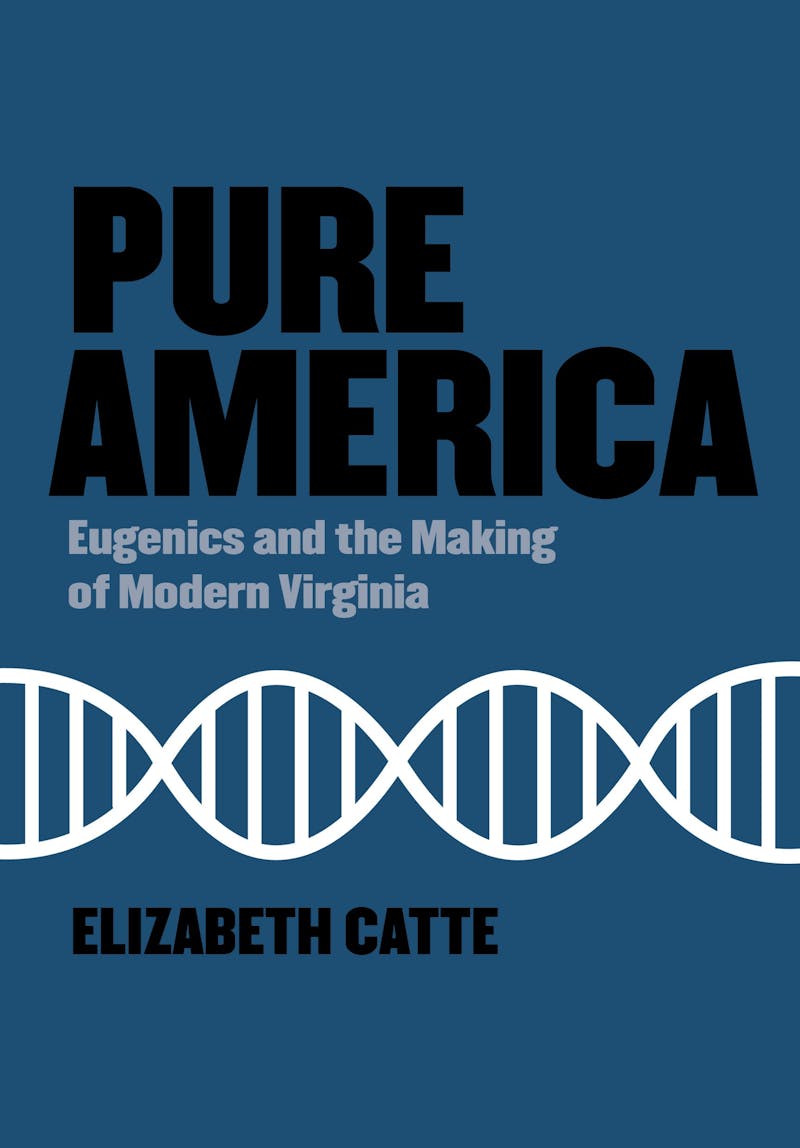The top-down quest for social control in America often seems to lead, by a deep-seated sort of homing instinct, to schemes of reproductive coercion. Tucker Carlson’s recent fulminations about racial “replacement theory” are but the latest in a long line of pseudo-Darwinian depictions of social decline. Carlson himself, of course, was cribbing his ugly tirade from the baldly fascist speculations of scores of alt-right propagandists, who in turn gained unprecedented access to state power via the labors of racist Trump apparatchiks like Steve Bannon and Stephen Miller.

Behind all these latter-day blood-and-soil obsessions is the specter of eugenics—the early-twentieth-century pseudoscience that sought to uphold a hierarchy of social privilege by stamping out the genetic bloodlines of supposedly inferior and intellectually disabled people via a campaign of mass sterilization. The gruesome program of white elite social domination that mainstream demagogues such as Carlson can only hint at was the explicit calling card of the eugenics movement, which at the height of its influence in the 1920s got sterilization programs targeting criminals, the mentally ill, and nonwhite minorities passed in more than 30 state legislatures.
In Pure America, Elizabeth Catte, author of What You Are Getting Wrong About Appalachia, charts the enduring legacy of eugenic thought and practice in Virginia. Between 1927 and 1979, the state presided over the forced sterilization of more than 8,000 residents committed to state mental health institutions. It was, in fact, a forced sterilization in a Virginia institution that launched Buck v. Bell, the 1927 Supreme Court test case that created the land rush in eugenics legislation across the country. (Buck is today best known for Progressive jurist Oliver Wendell Holmes Jr.’s terse summary of the majority opinion: “Three generations of imbeciles are enough.”)
Virginia’s eugenics initiatives weren’t the most expansive in the country—that dishonor belonged to California, which presided over more than 60,000 forced sterilizations, disproportionately targeting the state’s Latino population. But in firmly adapting the racist logic of eugenics chiefly to a population of poor white mental health patients, Virginia showcased the way that the rhetoric of scientific social control could bend to any number of socioeconomic and hierarchical dictates beyond the Old Confederacy’s race-based model of elite domination. And this pseudoscientific dispensation directly fuels all manner of white supremacist sentiment on today’s reactionary right.
Catte lives in Staunton, Virginia, just outside Shenandoah National Park, home to the sprawling former grounds of Western State Hospital, where more than 1,700 forced sterilizations took place, and where eugenics enthusiast Joseph DeJarnette, the facility’s longtime superintendent, lent expert testimony in the Buck case. Nearby Charlottesville, where Catte’s partner works, was the longtime home of plaintiff Carrie Buck—a former domestic servant who had been rushed into the state’s Lynchburg Colony asylum at the age of 18, after a nephew of her employers, John and Alice Dobbs, raped her and she became pregnant.
Carrie’s widowed mother, Emma, had already been committed to Lynchburg in 1920, and classified in the crude testing argot of the time as a “moron”—“a class of people who were typically confined for life,” Catte writes. The Dobbses fabricated a history of recent unstable-to-dangerous behavior for Carrie as part of her commitment proceedings, and the same judge who had overseen her mother’s commitment swiftly engineered Carrie’s. Carrie was confined at Lynchburg after her baby’s birth and was sterilized after the high court decision in her suit—a veritable show trial, in which her defense was handled by Irving Whitehead, a lawyer who served on the governing board of the Lynchburg Colony. (In his nominal defense presentation, Whitehead fretted over the hypothetical spread of venereal disease once sterilized inmates were once more released into the world and predictably embarked “on a rampage” of procreation-free promiscuity; best to play things safe, he suggested, and leave the sterilized patients in question permanently confined.)
The circumstances of Carrie Buck’s commitment were not at all unusual—in another early eugenics case in Virginia, a Richmond woman named Willie Mallory was also confined at Lynchburg after her arrest on trumped-up prostitution charges. Her admitting examiner conducted some intelligence tests that failed to produce any signs of mental impairment; when the examiner told a court supervisor “I can’t get that woman in,” Mallory later testified, the court official replied, “Put on there, ‘unable to control her nerves,’ and we can get her in for that.” In short order, she was confined and sterilized; once she was released, she was forbidden any contact with her husband or her younger children on pain of recommitment. The only way to keep the family intact was to sue Lynchburg’s ghoulish and dogmatic eugenicist supervisor, Albert Priddy; because the facts of the case were so egregious and Willie Mallory’s admissions records were badly incomplete, the Mallorys prevailed.
But the victory was Pyrrhic, at best: The defeat left Priddy and his allies in the Virginia social science establishment all the more determined to prevail in the Buck case. “No one wanted to be humiliated like Priddy,” Catte writes, “forced to downplay their work as something that was only beneficial to worthless women. There was a better world to build, and it would not be done in the shadows.”
Indeed not. Even before the Buck ruling, Virginia endorsed a Racial Integrity Act in 1924—a companion piece to the state’s Sterilization Act, passed the same year—largely thanks to the fierce advocacy of Walter Plecker, the head registrar of the state’s Bureau of Vital Statistics. The act sought to codify the infamous “one drop” mythology of white racial purity as an inviolable principle of human breeding, so as to fend off the dread specter of white bloodlines contaminated by African American and Native American sources. Plecker pursued this twisted aim with an Ahab-like rage for order; he managed to get Native Americans essentially written out of Virginia demographic records after elite white citizens obtained a loophole in the act nullifying its provisions for people with one-sixteenth or less of Native blood. He was convinced the loophole would lead to countless spurious claims of white identity among the mixed-Native population, and his mania to fend off this specter of racial contamination was so deep-seated that he preferred to wish away the Native American presence in the state entirely. (Pamunkey Tribe Chief William Miles later labeled this an act of “statistical genocide, which Plecker would presumably have taken as a compliment; Plecker boasted, of his own efforts, that “Hitler’s genealogical study of the Jews is not more complete.”) Nor was Plecker’s racial monomania confined to the domain of the living: He canvassed Old Dominion cemeteries, seeking to drive away the specter of otherworldly race contamination by ensuring the segregation of interred corpses.
Catte’s bracing and detailed recreation of the world of Virginia eugenics conveys the full reach of its legacy. In the same year that the Racial Integrity and Sterilization Acts won approval, the city of Charlottesville unveiled its statue of Robert E. Lee—a symbolic elevation of the old Confederacy in the midst of a confident new regime of racial impunity, imbued with the rhetoric of advanced social planning. The racialized and class-bound future that Lee’s statue presided over was “a living, breathing, modern enterprise,” Catte observes, “that had been secured through an alliance of law, science, education, and, above all, power.” Catte skillfully narrates the saga of modern Charlottesville in the shadow of this new social compact: the gentrification of the formerly Black neighborhood of Vinegar Hill; the artificial housing scarcity created by the city’s segregationist zoning laws; and, of course, the deadly 2017 “Unite the Right” rally convened on the pretext of preventing the Lee statue’s removal.
Catte also revisits the controversial clearing of occupied farmland to create Shenandoah National Park in 1935. It was during this battle, steeped in eugenicist rhetoric, that Mandel Sherman and Thomas Henry wrote the bogus 1933 ethnographic study Hollow Folk. Ostensibly a study of the isolated rural people who lived on (and were about to be removed from) that land, the book is notable mostly for transposing long-standing racist canards about African Americans (attributing to them inferior intelligence, indolence, and relative insensibility to pain in childbirth) onto poor white rural populations. It described them as forlorn and inbred people who had descended from once “pure stock” into a squalid condition hopelessly out of the mainstream of modern progress. Like the voyeuristic and gothic accounts of rural poverty and anomie in works such as J.D. Vance’s Hillbilly Elegy, Hollow Folk doted on the terminally clueless and maladapted behavior of its research subjects, such as an old woman foraging for discarded vegetables in a refuse heap while she wore a once-fancy evening dress that had been similarly scrounged from a neighboring resort. As Henry explained in an accompanying series of profiles in The Washington Star, this out-of-step habitus was all but earmarked for mass removal, rooted as it was in “hidden communities of backwards, illiterate people living in medieval squalor.”
There is a clear line from this work to today’s race-baiting intellectual industrial complex; in each instance, Catte writes, a “hardline emphasis on race and genetics” acquires “the softer bordering of cultural theories without changing the ultimate conclusion.” Just consider the work of arch-neocon and libertarian race theorist Charles Murray in this regard, Catte writes: “After arguing, on the basis of IQ testing, that Black people are irreversibly less intelligent than white people in 1994’s The Bell Curve, Murray has pivoted in recent years to the subject of white plight and the genetic realities of class structure.”
The most surreal update of the state’s old eugenics infrastructure is taking place in Staunton, however, where the former grounds of Western State Hospital were sold to private developers, who’ve plonked down $250 million to launch a massive high-end condo project called the Villages at Staunton on the site, pitched at a retiring Boomer demographic at an asking price of around $500,000 per unit. (The median household income for Staunton, Catte notes, is around $45,000 a year.) The development is also anchored by a stylish resort called the Blackburn Inn, which, like the condos, is tastefully rendered in the neo-Jeffersonian architectural style of the original hospital. Promotional materials for the project, not surprisingly, offer a distinctly bowdlerized version of the Western State’s past and heritage, completely eliding its role in the early-twentieth-century eugenics boom.
As Catte digs into the Western State archives, she finds that superintendent DeJarnette oversaw his own tasteful neo-Jeffersonian plans to expand and update the facility’s physical plant—and did so while relying entirely on the labor of its inmates. (This, too, was a key selling point of eugenics during its heyday—sterilization was held to create a more stable, compliant, and productive workforce, particularly in the sphere of domestic service, where Lynchburg in particular supplied a reliable contingent of female inmate labor to wealthy Virginia families after the patients’ release.) In other words, the architectural inspiration for the high-end preservationist Villages at Staunton is the actual handiwork of an inmate population that supplied a steady stream of eugenics test subjects on DeJarnette’s watch.
Digging further on the development site proper, Catte finds that the developers also acquired—and cordoned off behind concrete barriers—the burial grounds of some 3,000 Western State inmates who died at the hospital; their graves remain unmarked save for the inmates’ admission numbers, thanks to a loophole the developers obtained to sidestep a recent state law requiring archival identification of heretofore anonymous graves. (The loophole and the burial site both feel, in turn, like direct legacies of the racist statistician Walter Plecker.) Here, etched indelibly onto the serenely well-appointed grounds of the Villages at Staunton, is today’s own de facto New South social compact, dedicated to walling off and submerging the remaining vestiges of the last century’s racialized regime of utmost social control. It strikes me as the sort of place where Tucker Carlson would feel right at home.
As it happens, Catte’s sharp and nuanced account of fractured working-class families and state mental institutions has a very particular resonance for me. I spent the first nine years of my life on the grounds of a state mental hospital in western Illinois, where my father worked as an activities therapist. (Our family lived in a no-frills blockhouse there; these were the living quarters for junior staff like my dad, and they were rumored to have formerly housed German POWs during World War II.) Illinois never fell under the spell of Progressive-era eugenics, so my hospital home was nowhere near so sinister as it might otherwise seem. (Indeed, the inmates who were permitted out on the grounds were unusually friendly to children, so my upbringing there mostly gave me an entirely distorted impression that all adults were engaged, relatable conversation partners for kids—a misapprehension that I discarded in record time once my family moved.)
My mother, however, hailed from Washington state, where she narrowly escaped a disastrous family meltdown in the wake of her parents’ divorce. Her dad was an Army electrician; her mother was an erratically employed domestic servant for much of her life, who suffered from haphazardly diagnosed mental ailments, from delusions to persecution complexes, that landed her in both the courts and the state’s far from benevolent public health system. A fierce battle over custody of the couple’s three daughters ensued. My mother was then 16 and managed to escape the worst of it by moving in with her then-boyfriend; her sisters were less fortunate and briefly were wards of the state. And Washington did have a hard-line eugenics law on the books, until the Supreme Court overturned it in 1942. My grandparents’ divorce happened about a decade after that, but that’s rather cold comfort.
It’s all too easy, in short, to envision a slightly altered turn of events, by which the brutal ideology of eugenics might have entrapped my own family, and a Pacific Northwest version of Joseph DeJarnette or Walter Plecker might have seen to it that I wouldn’t be typing these words at all, for the very simple reason that I wouldn’t have been permitted to exist. I guarantee that’s something that I will keep in mind the next time I’m confronted with yet another Trumpian diatribe on the menacing outsiders allegedly scheming to replace their sacred white birthright. Sorry, assholes, but your self-mythologizing transports are just so many Herrenvolk adumbrations of a singularly bankrupt and predatory will to power—and Elizabeth Catte has done us the inestimable service of showing us the real and enduring costs of continuing to take your vicious ideology seriously.








